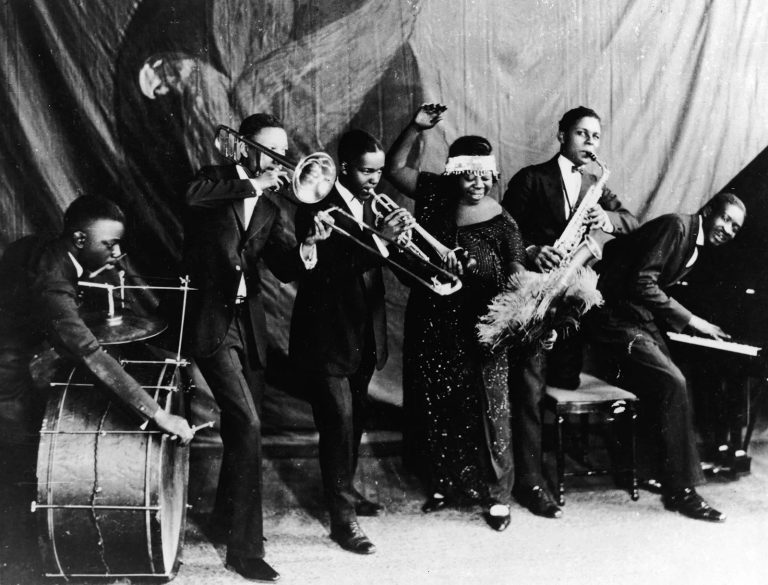In this article, we will share our views on the birth of “blues” music, its origins, its characteristics, and the musical genres it feeds on and feeds into.
The word “blues” is thought to have its origins in the term “blue devils”. Even though “blue devils”, in direct translation, means “blue devils”, in common usage it means “depression”, “delusions” and is mainly used for the symptoms of “deficiency” experienced by people trying to recover from “alcohol addiction”. The current use of the term “blue law” for the prohibition of alcohol on Sundays confirms the origin of the term.
Over time, the term “blue devils” has been replaced by the word “blues”, which is now used outside of music as “sadness”, “the pain of separation”, “a state of sadness”. Blues music is thought to evoke similar feelings in its listeners. It is possible to say that the blues, especially in its early periods and of course without excluding the present day, carries these emotions. Most of the early blues songs are not narratives, but expressions of emotion. These expressions of emotion also form the lyrics of the songs. Usually performed solo, blues songs are sung lyrically accompanied by a guitar.
When the blues is subjected to an origin research, we come across as a music performed by African natives who were brought to 19th century America as slaves. However, such statements should be corrected as the “birth” of the blues. This is because the blues is made possible by the presence of individuals with this asset in the “space” and “time” where blues music emerged.
Let us elaborate on this point.
The system of slavery practiced by the West in its colonies was perpetuated with the indigenous peoples who were brought to and settled in America. While these peoples are most commonly known as African natives, it is also seen that slaves were brought from many regions such as Indians and Far Easterners. In this article, we will talk about the natives brought from Africa and their wealth.
African natives brought to the Americas as slaves were forced to perform all kinds of physically difficult and dirty labor. These included land reclamation, cutting wood, cleaning, sexual exploitation, as well as the establishment of “slave production areas” for “slave production”, where women were forced to become pregnant, rape, incestuous relationships, and many other forms. In this article, we will not reveal the extent of the systematic oppression. The details of the subject can be seen through a simple research.
In places where African natives brought as slaves worked en masse, especially in the fields, the workers sang songs called “hollers”, which literally translates as “shouts”. In terms of performance and participation, these songs are similar to the “sea shanty” of sailors. It is possible to detect this form of performance, which provides a kind of “commonality of fate” and “healing”, in places where people work collectively and rhythmically. As long as these hollers are performed, physical actions such as “throwing anchor” and “rowing” are performed in synchronization.
Let us examine the origin of hollers.
“Holler”, or “field holler” as it is commonly called, is a type of song that is usually performed solo and vocally in accordance with the tempo of the workers working in the fields or chopping wood. In particular, the use of “vibrato” and “melisma” is similar to the call to prayer and the recitation of the Qur’an. For this reason, historians such as Diouf trace the origin of hollers to the Islamic rituals of African natives.
The musical structure of the holler should be evaluated by focusing on the original musical structure. Because the original music carries the principles of universal music. The general structure of a music can only be understood by looking at the principles of the original music. The most beautiful and “complete” example of original music is Turkish music. For this reason, taking Turkish music as an example can provide an easy and straightforward result in this type of evaluation. The fact that Turkish music is a complete example of original music can be examined in the work “Nazar’i Musıki’nin Esasları-Türk Musikisi’nin Zemini Üzerine Bir İnceleme” (Koç, 2011). Turkish music is music heard from an external stage. The subject of music heard from the outer stage should be understood by remembering the concepts of inner stage and outer stage.
One of the most important concepts of original music, that is, music, is time. Closely related to the concept of time, another important concept duo is usul and makam. In the context of the concept of makam, another fundamental concept of original music is pitch. Without taking into account the concepts of usul, time, maqam and pitch, the issue of the principles of original music cannot be fully and adequately addressed. Usul is the essence of the time specific to music. Music has its own time, and this music is composed of the melodies that are built in this time. The architecture of melodies also requires the concepts of makam and pitch to be taken as a basis.
The “time” specific to “Turkish music heard from the external stage” is formed by “kudüm darb’ü”, by applying “force”. The “time” is “closed” and “opened” with each “blow”. Thus the force-time circle is formed. By “darbetting the force-time-circle”, the “force-time topo-graphia” is formed. The pitch specific to Turkish music is formed by blowing the nây by applying force. The sounds coming from the source in the pitch scale are absorbed in the force-time circle and the force-time-pitch topography is formed with the sound rhythm in the pitch scale. Thus, sound architecture is formed on the basis of the unity of usul and makam in Turkish music. (For a detailed analysis, see Koç, 2011)
The “holler”, or “field holler” as it is commonly called, is a time when workers in the field or chopping wood, strike their tools against stone, wood or earth, opening a time, a time for music. In this time, a melody is made by means of the bare voice. From this point of view, it can be said that what is “done” in the hollers is close to and in accordance with the principles of general music.
In “Turkish music”, the “opening (making) of time” is done with “strong”, “weak” and “weak” “strong strokes”. As far as can be determined, there are only “simple” beats in the “hollers”. However, in terms of the “length of the times struck”, “form” and “strength-time-circle”, the hollers are “weak” compared to the “usul” diversity of “Turkish music”. Similarly, the “pitch” and “makam” diversity of “Turkish music” is also absent in hollers. It should be noted that we have made these observations in the context of the holler performances we have received and that our “diagnosis” is based on the “music heard from the outside stage”. However, in terms of the music performed in the “Greco-Latin-Church” realm, it can be said that the hollers are close to the original music. This is because the music performed in the “Greek-Latin-Church” realm is inauthentic in terms of “usul” and “makam” cancellation.
The tradition of holler, brought to the Americas by the African natives who were brought as slaves, has been performed as a “reaction”, “expression” and “healing” to the hardship and oppression they were subjected to. “Hollers” have taken on a new “form” over time with the acompani instruments, such as the guitar, already present in the Americas. This “change” can be seen as a sign of decline. We briefly touch on this point in the rest of the article.
Of course, the source of the blues is not only the hollers. The influences of church music, ragtime and popular music performed in America, in other words, the music of the period, were also influential in the formation of the blues. The origin of the genre called ragtime is based on the varidat of African natives. Since this point is not the subject of this article, we will not go into detail.
We see the first nuclei of the blues in this decline phase. The “12-part-tampereman” system, which is a characteristic feature of the music of the Greek-Latin-Church realm in terms of its later structure, appears as the basic feature of the blues genre as it falls from the hollers. Regardless of the musical genre, all structures that are based on the 12-part-tamperament system are incompatible with the original music. We will explain this by taking into account the Greek-Latin-Church notion of “music heard from the outer stage”.
According to “modern physical theories”, a “sound” is a “vibration” that “propagates” as a “wave”. The “vibrating matter” as the “source” “emits sound” through a “medium” such as “air”, “water” or “gas”. The “frequency of vibration” of the “matter” or the “sound” “emitted” in the “medium” is called “frequency”. A “sound”, a “frequency”, is mathematically “modeled” by a “sinusoidal wave function”. The quantitative doubling of a “frequency” is called the “first harmonic”. We have partially touched upon “harmonics” and in particular “harmonic components” in our article “Reflections on Metal Music”.
According to “modern music theories”, each “sound”, to the extent known, “propagates” at multiple “frequencies”. A “sound”, according to these “theories”, is “inkeb”. The dominant “frequency” component of a “sound” in terms of “intensity” is called the “fundamental frequency” of that sound. This “fundamental frequency is referred to as a “note”.
The “interval” formed by a “note” with a “sound frequency” that is “quantitatively” twice the “sound frequency” of a “note” is called an “octave”. This “octave” is divided logarithmically by 12, and this 1/12 “interval” is called a “semitone”, resulting in the “12-equal-tamperament” system. “Modern western music” uses this “12-equal-tamperament” system, with exceptions. Let us briefly mention these exceptions.
Contemporary music performers and composers, finding the “12-equal-tamperament” system “restrictive”, have developed “pitch” systems called “microtonal”. In this way, they sought a broader basis than the 12-equal-tamperament system. Although the efforts and intentions of these music theorists are meaningful, due to their inability to unravel the fundamentals of the original music, what they have achieved has nothing to do with the original music in this regard. Because all of these efforts are realized through mathematics based on flat topography. However, “theoretical music” cannot be performed with a “mathematics” based on “flat topography”, no matter how many “micro-screens” are created. The origin of this endeavor can be traced back to Pythagoras. Those who established the mathematics of the Greek-Latin-Church realm were unable to construct a mathematics based on a topography different from flat topography. This issue is one of the main sources of these problems. It is not possible to expand the objects of mathematics on the basis of flat topography without seeing the “inner topography” that is different from flat topography. This problem, in fact, stems from the fact that the concept of interior has never been established in the Greek-Latin-Church realm more generally. On the principles of interior topography, see (Koç, 2009).
As a result of these deficiencies, which are not based on the original music, vocal performances in terms of “pitches” in the music of the Greco-Latin-Church realm are also confined to this “ground”. In this respect, the blues, which is performed with the guitar and which transitions to the non-original “ground” of western music, falls from the hollers, which are considered to be close to the original music.

Now, by talking about the elements and composition of blues music, we can see a little more closely the problems arising from the basic deficiencies mentioned above. The “pitch” terminology we will use will be based on “solfege” as the way the “Greek-Latin-Church” realm “put music on paper” and “expressed” it. For this, it is necessary to briefly touch upon the subject of solfege.
“Solfege” is a way of representing and writing “sounds”, “pitches” and “notes”. This system “names” sounds that are one “octave” apart with the same “sign”. In this respect, “pitches” with an “octave” interval between them are marked repeatedly. The main reason for this is the absence of “harmony” in the music of the “Greek-Latin-Church” realm. We do not elaborate on the concept of “harmony”, which is one of the main characteristics of Turkish music. Suffice it to say that it is not possible to reduce “harmony” to “transposition”.
It should also be noted here that in “Anatolian Turkish music” no two “pitches” are “named” with the same “sign”. Because each “pitch” is individual. According to the Arel-Ezgi-Uzdilek system, the theory “reduced” to the “solfege” system, for example, “Rough Rast pitch”, “Rast pitch” and “Gerdaniyye pitch” are “signified” with a single name, namely “Sol”, in the “solfege” system. The Arel-Ezgi-Uzdilek system has “faults” in these matters. We will talk about these “faults” in a separate article.
Now let’s talk about “blues harmony” using the “solfege” system.
According to “Western harmony theory”, the basic blues scale consists of six “voices”. These six “voices”, if we consider the basic “voice” to be the note “La”, are formed by adding the “half-voice” pest of the fifth “voice” of the scale to the “minor pentatonic scale”, which consists of the “La-Do-Re-Mi-Sol” “voices” from “high” to “treble”. This note is also called the “blue note”. This results in the “La-Do-Re-Mi(b)-Mi-Sol” scale, the basic blues scale. Similarly, various “blues scales” are obtained by “adding” and “subtracting” to the “major scale”. This is encyclopedic information.
“Additions” and “subtractions” can only create an “ink” “structure”, a “building” without a “foundation”. For what goes into “composition” does not constitute “unity”. The theory that emerges as a result of this endeavor is “heart” in the sense that it has nothing to do with the original music. It is only a “forger” who describes the “heart” as the “original”. This determination is valid for any “musical theory” that takes the “12-equal-tamperament” system as its “ground”.
In this article, we will not touch upon the harmonization and harmonization based on “chord” repetitions such as “12-bar-blues”, which was frequently used especially in the early periods of blues music. The issue of “twin” and “triplet” “image birth”, which should be discussed in a broader framework, is beyond the scope of this article.
As a result, it can be concluded that the blues has declined over time from the hollers, which were close to the original music in terms of their source, and has been confined to the “12-part-tampereman” system, and thus has been subjected to some deficiencies from its own origin. As with any decline, the blues will also bear the traces of the pre-decline period. For this reason, it is possible to think that the feelings that early blues products evoke in their listeners can be considered as a trace left behind by the performers of “hollers of yesteryear”, especially since the varidade “rabtolun” to the hollers reminds the blues listeners of the pre-decline period.
Let’s talk about one last point and conclude our article.
Although the blues has historically been the source of jazz music, it would not be correct to say that the blues is the only source of jazz music. Those who know the “course” of classical western music can also find the first nuclei of jazz music in classical western music. In this respect, the “ground” and “fundamentals” of jazz music are based on the “12-equal-tampereman” system, just like blues and classical western music. With what has been explained up to this point in the article, this subject can be easily opened.





